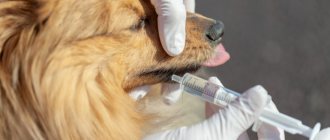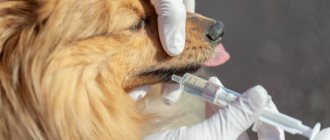The veterinarian talks about the disease
- Fact 1:
Pruritic scabies, as they also say when they mean sarcoptic mange, is a highly contagious skin pathology. - Fact 2:
Ear mites, ear scabies - this is what the common people call this infestation of a pet's ears by mites. - Fact 3:
Ear scabies spreads very quickly in the ear canal, spreading to the middle ear and then the inner ear - Fact 4:
Demodex is not contagious, although many believe otherwise. It is not transmitted to humans or other animals in the house
Canine scabies has several forms and causes. The definition of “scabies” includes several skin pathologies characterized by subcutaneous mite damage to the dog’s ears, upper or deep layers of the epidermis.
Sarcoptic mange
Pruritic scabies, as they also say when they mean sarcoptic mange, is a highly contagious skin pathology. It does not depend on the time of year and is unpleasant because female ticks in the epidermis literally gnaw passages into the deep layers of the skin, move along them and leave egg clutches. To gnaw out “tunnels,” the tick selects areas with short hair on the dog’s body, namely the head and joints. On the head, sarcoptic mange affects the pet's ears, the area above the eyebrows, and the back of the nose.
Sarcoptes - sarcoptes. They are very small in size and therefore cannot always be seen. These whitish parasites have a flat body and have hard spines on their legs, with which they easily cling to the fur and skin of animals and humans.
The first manifestations of the disease are barely noticeable dots, which become ulcers within 1.5-2 weeks. The sores are very itchy and do not give the animal rest.
Obvious symptoms of sarcoptic mange:
- Constant itching of the affected areas.
- Restless behavior of a ward who cannot find a place for himself.
- Scabs and crusts in places where scratches were made.
- There is bloody discharge under the scabs at the scratch site.
- Abnormally large amounts of dandruff (especially in the ear areas).
- "Ear-foot" reflex. When touching the shell of the ear, the pet instinctively tries to itch.
Diagnosis involves laboratory testing of scrapings from the affected areas of the epidermis. Samples are taken from the deep layers of the skin by making an incision until the blood is drawn to collect biomaterial.
Symptoms of scabies in a dog
The main symptom of scabies in dogs is itching, and specific signs and treatment depend on the type of pathogen. The constant desire to scratch, resulting in bloody scratching, is explained by irritation of nerve receptors. Other reactions to parasites can be divided into 2 large groups:
- are common
: bowel dysfunction, loss of activity, poor appetite, lack of coordination;
- local
: redness, swelling, purulent inflammation, pain, increased local temperature.
Soon after infection, the pet falls into apathy, refuses its favorite treats and reacts aggressively to any attempts at contact. His body temperature may rise and be accompanied by chills. All of these symptoms resemble a common cold, so check for more obvious signs:
- redness and cracking of the skin;
- the formation of dandruff, scabs or pus with a pungent odor;
- severe itching, forcing you to scratch until it bleeds;
- local hair loss, leading to baldness on certain parts of the body.
Symptoms are especially pronounced in puppies, young dogs (up to 2 years old) and animals with chronic diseases. It is also worth noting that purebred pets tolerate tick infestations more easily than purebred pets.
Otodectosis
Ear mites, ear scabies - this is what the common people call this infestation of a pet's ears by mites. Most often, it affects dog breeds with drooping hearing organs. Their structure and shape are the most optimal in terms of conditions for the reproduction and life of the parasite. The pest is located in the external auditory canal and the auricle. With prolonged direct contact of a sick animal with a healthy one, the tick is transmitted to a neighboring organism. Cases have been recorded in which a person became infected with otodecosis from their sick pet.
Otodectes cynotis , which lives on the surface of the skin. The tick parasitizes only one area of the body – the ears of animals.
The ectoparasite attaches itself to the upper layer of the skin and begins to actively function, feeding on dead epidermal cells, blood, and earwax of the animal. Having reached maturity, the causative agent of scabies penetrates deeper into the skin, causing unbearable itching.
Signs of otodecosis:
- The animal shakes its head all the time and tilts it towards the diseased ear organ.
- Starts to rub against hard objects with force. Sometimes this causes cuts, scratches and other microtraumas, which later begin to fester.
- A brown “gluten” forms in the ear—excretion products as a result of the tick’s activity.
Ear scabies spreads very quickly in the ear canal, spreading to the middle ear and then the inner ear. Through it, the disease can reach the meninges. Without timely treatment, otodecosis leads to complete hearing loss. Despite the pronounced symptoms, laboratory tests are often required to make a correct diagnosis.
How dangerous is the disease?
Itching mites are aggressive creatures that will not leave their host without special treatment. The longer they stay in the body, the more significant harm they cause to dog health:
- Decreased immunity. A constantly itchy dog loses its appetite and interest in life. As a result, the resulting exhaustion has a bad effect on the immune system.
- Intoxication. As ticks multiply, the products of their vital activity accumulate in the body. They enter the blood, which leads to intoxication of the entire body.
- Penetration of infections. By scratching its skin, the animal inflicts wounds and scratches on itself, creating an entry point for various infectious diseases.
- Pathogenic microflora. Inflammation of skin areas provokes the occurrence of dermatitis. Areas of irritation become crusty, disrupting skin heat exchange and oxygen penetration. This creates conditions for the proliferation of pyogenic bacteria, staphylococcus, streptococcus.
As a result of these factors, the dog’s cardiovascular and nervous system is disrupted, which leads to the development of side pathologies.
Demodicosis
Another very common pruritic skin lesion in the canine tribe. The causative agent is the demodex mite. This parasite is present in limited quantities in any dog as part of the normal microflora. Under favorable conditions, and this is either a weakened immune system or a genetic predisposition to dysfunction of T-cell immunity, an abnormal, rapid increase in the Demodex population begins.
Demodex - Demodex are mites that live on the body of an adult dog and do not cause any problems as long as the animal's immune system is in good order. When the body is impaired or weakened, the parasite begins to multiply uncontrollably and affects large areas of the skin.
The parasite operates in hair follicles and on the skin surface. Demodex is not contagious, although many believe otherwise. It is not transmitted either to humans or to other animals in the house. The disease begins suddenly, without any apparent reason. Demodex mites mainly affect the dog's muzzle and organs of vision.
Veterinarians know two types of demodex:
- Localized . 4-6 lesions on the pet’s entire body. Puppies 3-6 months old are susceptible to the disease.
- Generalized . The localization of the spots is more extensive, more than 5. The age for the lesion is from 3 months to one and a half years.
Routes of infection
A dog becomes infected with ticks mainly through contact. An indirect route of transmission of scabies through toys, bedding and other objects is also possible if there is a high concentration of parasites on the animal’s body. A pet can become infected from these ticks; ticks are capable of attacking wild and domestic carnivores (cats, arctic foxes, foxes, ferrets).
In dogs, the disease appears 14 days after infection. The tick mainly affects the neck, head, and limbs of the animal. The most susceptible to infection by parasites are young and weak individuals, in whom the symptoms of the disease develop rapidly. Smooth-haired dogs are more susceptible to tick attacks.
Notoedrosis or Cheyletiosis
Cheyletial scabies infection is a very contagious disease, the treatment of which must be carried out without delay, since the mite can infect not only the dog, but also the owner in particular. The parasite lives in the upper part of the epithelium and lives by absorbing tissue fluid and dead cells. Most often localized in the cervical, dorsal and ear regions.
Cheyletiella - cheyletiella . A tick that is extremely contagious. It usually lives in the area of the animal's neck and ears. It can bite a person like a flea, but does not live on it for long.
Identifies the following symptoms:
- Characteristic loss of wool hairs in clumps.
- The animal scratches uncontrollably at infected areas of the body, which may be inflamed.
- The formation of ulcers and rashes, as well as dense scales and crusts.
The most unpleasant type of scabies disease is notoedrosis. The tick that causes itching is localized deep under the skin epithelium and moves freely, so the disease is considered very contagious and can spread to the dog’s owner.
Characteristic signs are observed
- on the frontal lobe
- eyebrows,
- in the head and nose area,
- and look like small bubbles.
The main symptoms in young dogs are hair loss. It is not recommended to treat the disease at home without first examining the animal at a veterinary clinic.
Types of disease
Scabies in pets is caused by various types of mites that attack different layers of the skin. Animals have no age or breed predisposition to infection, so parasites can attack any dog. Ticks are dangerous for small puppies who do not have a developed immune system to fight the complications and consequences of the disease.
Sarcoptic mange
Sarcoptosis is a disease caused by the small tick mite Sarcoptes scabiei, which lives primarily on dogs. The peculiarity of the disease is severe itching, poorly controlled by medications.
The scabies mite easily penetrates the body and multiplies intensively, going through all stages of development from larvae to adult. It parasitizes under the skin, feeding on biological material: interstitial fluid, lymph, serous exudate and dead epithelial cells. There he gnaws passages where he lays his eggs. Ticks can also attack humans, causing pseudosarcoptosis, but these parasites do not reproduce in human skin and do not gnaw passages.
The first symptoms of the disease are reddened spots on the skin, mainly in areas with short hair: on the head, knee and elbow joints, and lower abdomen. As the disease develops, the entire surface of the body is captured, fistulas, purulent wounds can form, and a secondary infection can occur. Outside the host, ticks do not reproduce, but are able to survive and remain mobile for up to 50 days, depending on environmental conditions.
Demodicosis
Demodicosis is caused by the Demodex canis mite, which affects the skin and internal organs of the animal. The parasite has a cigar-shaped appearance and lives near the sebaceous glands and in hair follicles.
A pet becomes infected from other dogs, and this often happens during the molting period, when there is no hair in the follicle. The tick crawls there and moves deeper. But in weakened animals, with a decrease in skin tone, the parasite can penetrate into the gap between the hair and the funnel of the hair follicle.
By gnawing passages in the epithelium, the parasite allows other mites to penetrate the same follicle, forming a whole focus-colony of mites. The products of their vital activity have a toxic effect on the dog’s liver, which ultimately destroys it.
Doctors divide the disease into forms:
- Scaly;
- Pustular;
- General.
In the scaly form, areas of flaking form on the animal’s skin, and dandruff appears in large quantities. With pustular pustules, pustules appear under the skin - compactions no larger than a centimeter in size. Blood and purulent discharge come out of them, which dry out and turn into crusts. In the general form, mixed symptoms of the other two appear - both scales and pustules are formed.
The dog develops oxygen deficiency due to impaired skin respiration and increased heat transfer. If the disease is neglected, it becomes chronic with hardening of the superficial lymph nodes. And with a weakened body, pathologically irreversible processes are possible, leading to the death of the animal.
Otodectosis
The culprit of otodectosis, the mite Otodectes cynotis, settles in the auricle and ear canal of wild carnivores, cats, ferrets, dogs, and rarely in humans. Once infected, the animal rubs its ears against various objects, injuring the skin, and shakes its head. Pets with large drooping ears often get sick in warm and humid environments. With this auricle there is a favorable habitat for ticks.
The ear canal is filled with viscous purulent contents, sulfur and mite waste products, causing inflammation. It can spread to the inner ear, leading to deafness, and the brain. The animal's body temperature rises, nervous attacks and a depressed state are possible. The owner may suspect something is wrong if the dog constantly holds its head tilted towards the affected ear.
Cheyletiosis
The disease is caused by the ear mite Cheiletiella yascuri, which feeds on the interstitial fluid and lymph of the animal. When infected with this mite, the hair on the ears, back and neck thins and does not adhere well to the skin. Increased skin pigmentation, purulent rash, itching appear, crusts and areas of baldness form.
The peculiarity of the infection is severe peeling of the skin and a lot of dandruff containing live mites (wandering dandruff), so the disease is contagious. People can be attacked by ticks, but the parasite does not live long on human skin and cannot survive.
Notoedrosis
The disease is caused by the subcutaneous tick Notoedres cati, which affects dogs, cats, rabbits, and people. You can get infected from a pet, but the tick retains its vital capacity on human skin for no more than 30 days (an unusual host).
The disease manifests itself as painful itching and skin irritation. As inflammation develops, the skin becomes covered with a yellow-gray scab, thickens, wrinkles, and areas of baldness may form.
What will happen if left untreated?
Parasites found in a dog's ears pose a great danger. Unqualified assistance or its complete absence can lead to serious consequences - deafness, meningitis. These pathologies, in the absence of veterinarian help, in most cases lead to death.
The main danger of ear mites is that even after a course of therapy, relapse and deterioration of the pet’s condition are possible. This is due to the fact that not all medications are effective against mite eggs. Thus, after treatment, larvae appear from them, which begin to feed on the blood of the pet, while the dog experiences serious discomfort - constant itching, shaking its head, itching, any sudden movement causes pain.
Ticks can provoke the development of an infection that is dangerous to the dog’s health and life. According to statistics from veterinary practice, a third of all infectious diseases end in the death of a pet.
General methods in the fight against tick-borne parasites
The type of parasites does not affect the course of the treatment process, in the sense that there cannot be a quick recovery, since in order to completely cure a pet, an integrated approach is required. Today, the variety of medications has no limits; you can use a special cream, ointment or spray as prescribed by a veterinarian. The treatment process is most active if the dog is cut, washed properly and the whole body is treated with a medicinal product. The main thing is to get rid of parasites.
Treatment, medical procedures, therapy
The following treatment regimens are most effective:
- Lubricating the areas affected by ticks with a solution of hyposulfite (sodium thiosulfate) at a concentration of 60%. A protective collar is placed on the dog's head to prevent it from licking the medicine. After the lubricated parts have dried, they are wiped with a 10% solution of hydrochloric acid. The procedure is repeated after 3 days. Two procedures are enough to completely destroy the tick.
- In the absence of the above-described drugs, you can inject the dog subcutaneously with the drug Ivomek (or any drug based on ivermectin - Tsevamek, Novomek, Baymek, etc.) at the rate of 300 mcg per kilogram of the animal’s weight.
- Bravecto tablets can be used against this type of tick .
- You can buy Bars drops , the active ingredient of which is diazinon. To kill ticks, you need to instill 3-6 drops of the product into each ear (depending on the weight of the animal). The instillation procedure is repeated after a week.
- Surolan drops have a wide spectrum of action. They are effective against ear mites, and also relieve allergic manifestations and eliminate inflammation. The instillation regimen is as follows: 5 drops 1 time per day. Treat each ear. Treatment lasts 14 days. The drug is acceptable for use in pregnant and lactating animals.
- Stronghold drops on the withers contain the active ingredient – selamectin of varying concentrations (6 and 12%). When treating ear mites, the drug is applied to the area between the shoulder blades once, and after a month the treatment is repeated. Cannot be used on puppies up to one and a half months old.
- The easiest way to treat scabies is the new Amidel gel Neo . This is one of the most effective domestically developed means used in the initial stages of infection. In advanced conditions, the drug is combined with ivermectin injections.
Amidel gel is a glycerin-based preparation containing:
- Cyflutrirn is a contact poison, safe for dogs, working in the upper layers of the skin.
- Lidocaine is an anesthetic that reduces itching and relieves pain.
- Chloramphenicol is an antibacterial substance that prevents the development of inflammation on the skin. Unlike antibiotics taken orally, chloramphenicol does not affect the intestinal microflora, therefore, dysbiosis does not develop from it.
- Dimethyl sulfoxide, polyethylene glycol-400 are auxiliary substances that have a softening effect on the formed crusts, which ensures the absorption of the medicine into the epidermis.
For better access to the affected areas of the skin, the hair around them is carefully trimmed. After destroying the scabies mite, wound healing ointments are used on the inflamed areas:
- Methyluracil,
- Levomekol,
- Solcoseryl.
To relieve pain, the dog is prescribed painkillers.
Secondary infection
I would like to pay special attention to this complication. Any itching will cause the dog to scratch furiously. Our task is to prevent this as quickly and effectively as possible, since the complication is always the same - a secondary bacterial or fungal infection of the skin. What kind of infection is this mysterious? This is a conditionally pathogenic microflora that always lives in the environment (including on the dog’s skin). When scratching, the protective surface of the dermis is destroyed, and all bacteria and fungi immediately strive to settle and multiply on this fertile soil. And this makes the situation even worse. Wounds (and these are real wounds), in addition to continuing to itch, also develop a crust, foul-smelling discharge, or even pus. Of course, this requires emergency care and comprehensive treatment.
Precautions and whether a person can become infected
Scabies mites can only grow on dogs. When they come into contact with human skin, they can cause pseudosarcoptosis, an allergic reaction to the presence of arthropods. They cannot feed, reproduce or gnaw holes; they die of hunger, but they are capable of causing discomfort.
Therefore, treating dogs against scabies mites must be done with gloves. An infected dog must be isolated from healthy pets. The latter must be subjected to prophylactic treatment with external agents that are used to treat a sick dog. The apartment is treated with insecticides twice, with an interval of 14 days.
Human scabies can only be contracted from monkeys. They are parasitized by the same type of scabies mites as humans. But precautions should still be taken when handling and handling sick dogs.
The danger of the disease for the animal itself
The danger of otodectosis lies in damage to the middle and inner ear, which can lead to hearing loss and the development of meningitis. The generalized form of demodicosis is complicated by problems with the lymph nodes, kidneys, stomach, spleen and liver.
Regardless of the type of scabies, numerous wounds in sick dogs increase the likelihood of secondary infection and death from sepsis. Death from exhaustion is less common, since the animal simply does not survive to this point, dying from associated complications.
Prevention
- It is necessary to systematically examine the animal, its skin and ears.
- Watch your pet. If his behavior has changed, the dog is itching all the time, is restless and his hair has begun to fall out - this is a reason to consult a veterinarian for advice.
- If possible, avoid places with large concentrations of animals, as well as forests and forest plantations.
- Do not allow sick pets to interact with healthy ones. At the veterinary clinic, keep your dog and cat away from other animals.
- Regularly treat your pets with medications against ticks, fleas and worms; if necessary, bathe cats and dogs with special shampoos.
- Systematically give your pet vitamins and minerals and strengthen the immune system in every possible way. This will minimize the likelihood of developing the disease and strengthen the body's protective functions.
Diagnostics
Sarcoptic mange is diagnosed based on clinical presentation, microscopic analysis of skin scrapings, and trial treatment.
It is not always possible to make an accurate diagnosis based on external signs, since the symptoms of scabies resemble other skin pathologies:
- atopic, flea, contact dermatitis;
- food allergies;
- demodicosis;
- superficial pyoderma;
- cheyleliosis;
- dermatophytosis;
- notoedrosis.
To clarify the diagnosis, a microscopic analysis is prescribed. Numerous superficial scrapings are taken from the dog from typical areas of scabies. The diagnosis is confirmed when mites, larvae, eggs, and excrement are found under a microscope. However, traces of parasites can be detected in only half of the dogs; according to other sources, in 20%.
An adult scabies itch under a microscope.
If the tests show a negative result, and the clinical picture of sarcoptic mange is obvious, then a trial treatment is prescribed. The diagnosis is confirmed when anti-tick therapy helps alleviate the symptoms and the dog is on the mend.
Before visiting the veterinarian and taking scrapings, the pet is not washed, treated with anything, or given any medications.
Veterinarian recommendations
Dogs infested with ticks should be clipped as soon as possible. Long hair does not contribute to treatment - it also obstructs air flow and causes irritation.
Hair trimming is the first step in preparing the skin for further treatment. The skin must be thoroughly cleansed using special products.
It is recommended to use shampoos, antipruritic drugs, and also give the dog anti-scabies after the end of therapy to prevent relapse of the disease.
It is also worth disinfecting brushes, combs, toiletries and other dog accessories, as mites can remain on them for several weeks.
Sources
- https://sobaki-pesiki.ru/chesotka-u-sobak-simptomy-lechenie.html
- https://usatiki.ru/chesotka-u-sobak-simptomy-i-lechenie/
- https://dog-care.ru/zdorove/bolezni/chesotka-lechenie.html
- https://kleshun.ru/chesotochnyj-klesh/
- https://KlopVred.ru/kleshhi/chesotochnye-kleshhi-u-sobaki/
- https://apest.ru/kleshhi/kleshhi-u-zhivotnyh/chesotochnyj-kleshch-u-sobak/
- https://deziplan.ru/kleshhi/o-kleshhax/chesotochnyj-kleshh-u-sobak.html
- https://VrediteliSOS.ru/nasekomye/kleshhi/podkozhnyj-kleshch-u-sobak.html
- https://vokrugsobak.ru/demodekoz-u-sobak-foto-lechenie-simptomy-preparaty/
- https://mirsobaki.ru/chesotka-u-sobak/
- https://www.1001dog.com/polezno-znat/vneshnie-kozhnye-parazity-u-sobak-i-ix-simptomy-na-foto.html
[collapse]











